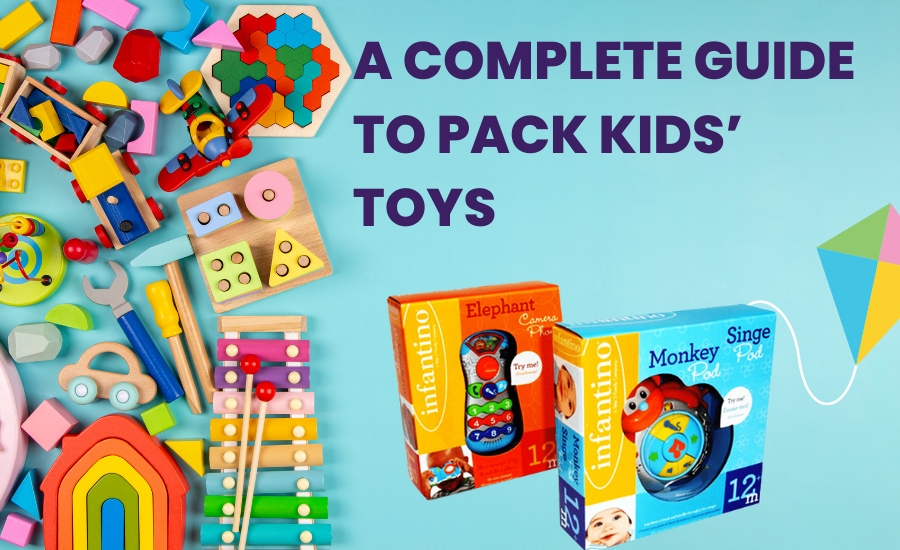When it comes to selling toys, packaging is super important. It not only protects the toys but also catches the eyes of potential customers. So, if you are in the toy business, you surely want to know about packing toy products appealingly. Well, have a look below for a complete guide to packing your kids’ toys!
What Type of Packaging Is Used for Toys?
First, let’s talk about the different types of packaging used for toys.
There are a few common options you can choose from here.
Cardboard Boxes
Cardboard makes excellent custom toy packaging boxes. This material is flexible, cost-effective, and customizable. Additionally, this packaging works well for puzzles, board games, action figures, and dolls. You can print attractive designs on it. Even better, you can add windows to show off your toy inside.
Blister Packs
Blister packs have a clear plastic front and a cardboard or plastic backing. They provide great visibility while keeping the toy securely in place. You will often see them packing smaller toys, collectibles, and action figures.
Window Boxes
Window boxes combine the visibility of blister packs with the sturdiness of cardboard boxes. They come with a clear plastic window that showcases your toy products.
Plastic Containers
Plastic containers are durable and reusable. You can see the packing of some toys like building blocks, art supplies, and small playsets. These containers not only protect the toys. More than that, they provide a convenient storage solution for customers.
How Do You Package Kids’ Toys?
Alright, now let’s talk about packaging kids’ toys. We know that it’s essential to keep your toys safe, attractive, and practical.
Here are some steps to follow!
Choose the Right Packaging Materials
Go for sturdy cardboard boxes, blister packs, or plastic containers that offer good protection. Make sure the materials are non-toxic because safety is a top priority.
Size and Shape Considerations
Your packaging should fit the toy properly, without too much extra space. Avoid using oversized packages that waste space and increase shipping costs. Instead, you should choose packaging that complements the toy’s shape.
Label Is Important
Yes, you must label your packaging. You should mention the toy’s name, brand, and age recommendations. Also, you must provide proper assembly instructions and safety warnings.
Child-Resistant Features
If your toy comes with small parts or can be potentially risky, child-resistant features are important. With these features, you can prevent those kids from opening the packaging without adult supervision.
Visual Appeal
Get creative with colors, engaging graphics, and eye-catching designs to make your packaging visually appealing.
Also Read: 10 Awesome Minigames In Zelda
Which Plastic Is Used for Packaging and Toys?
Well, we know that plastic packaging and toys are quite popular. In fact, there are different types of plastic we should mention here.
- Polyethylene Terephthalate (PET) – Lightweight and transparent. Ideal for clear plastic windows in packaging
- Polyvinyl Chloride (PVC) – A flexible plastic popular for its durability and flexibility
- High-Density Polyethylene (HDPE) – A durable plastic that can resist moisture and impact
- Polypropylene (PP) – It comes with excellent clarity, toughness, and chemical resistance
What Makes Good Toy Packaging?
In brief, good toy packaging goes beyond product protection. Far better, it should effectively communicate your toy’s value. Plus, it should help you appeal to customers.
So, below are some important factors you must consider!
- Eye-catching designs
Apply eye-catching designs, vibrant colors, and graphics. Remember that all these elements should resonate with your target audience.
- Highlight your toy products
Make sure your packaging clearly communicates the toy’s features, benefits, and play value. Plus, you must use simple language. This way, you can highlight any unique selling points that make your toy special.
- Easy accessibility
Your packaging should be easy to open, especially for parents who often have their hands full. So, don’t forget to add tear strips, perforations, or resealable closures to make it convenient.
- Branding and differentiation
Lastly, your packaging should reflect your brand’s identity and create a memorable impression.
How Do You Pack Bulky Kids’ Toys?
Undoubtedly, packing bulky kids’ toys requires some extra care. Additionally, you must ensure they arrive safely and without damage. Sounds difficult? Not really!
Here are a few tips for you!
Disassemble If Possible
If your toy can be taken apart easily, disassemble it to reduce its size. Wrap each component in protective material like bubble wrap or foam. This way, you can prevent scratches and damage.
Secure the Parts
Use zip ties, Velcro straps, or adhesive tape to keep loose parts together. This prevents them from shifting and potentially causing damage during transit.
Cushioning and Padding
Wrap your toy in plenty of cushioning material. For instance, you can use bubble wrap or foam, to absorb any shocks and provide protection. Plus, don’t forget to pay extra attention to fragile or delicate parts.
Use Sturdy Packaging
Choose a strong and appropriately sized box to accommodate your bulky toy. Besides, you must reinforce the corners and seams with packaging tape.
Fill Empty Spaces
Fill any gaps inside the box with additional padding material like packing peanuts or air pillows. This prevents your toy from moving around during shipping.
What Is the Best Way to Ship Toys?
Choosing the right shipping method is essential to ensure your toy products reach customers safely. After all, you surely don’t want to make those customers disappointed.
So, here are some best ways to ship your toy products!
- Packaging integrity
Before shipping, make sure your toy packaging is well-sealed and in good condition. Use packaging tape to reinforce the box’s corners and seams. By doing this, you can prevent any accidental openings.
- Select appropriate shipping materials
Use sturdy cardboard boxes and cushioning materials to protect your toy during transportation. For instance, you can go with double-walled boxes that offer extra strength, especially for fragile or valuable toys.
- Labeling and documentation
Clearly label the package with the customer’s address, return address, and any special handling instructions. Plus, don’t forget to include a packing slip or invoice inside the package for easy identification.
Final Notes
Packaging toy products appealingly is essential for success in the toy industry. Remember to choose the right materials, create eye-catching designs, and prioritize safety. By following the tips in this guide, you can create packaging that not only protects the toys. More than that, you can design ideal packaging that captivates customers and enhances the overall toy experience.
Good luck!



